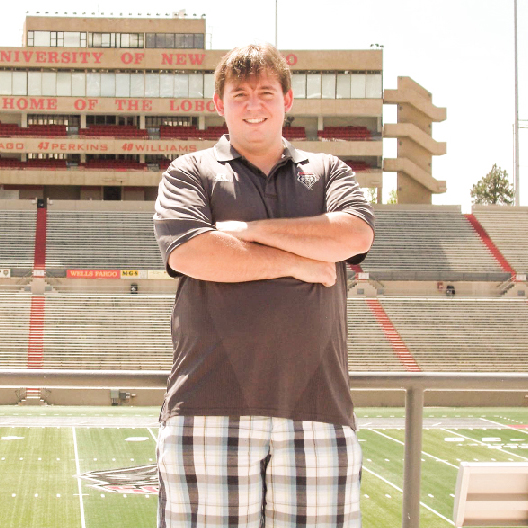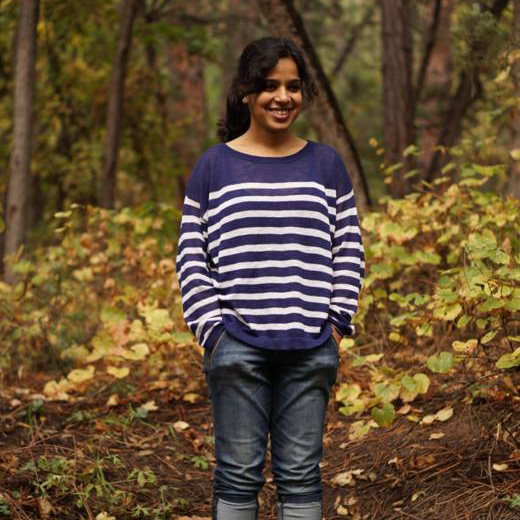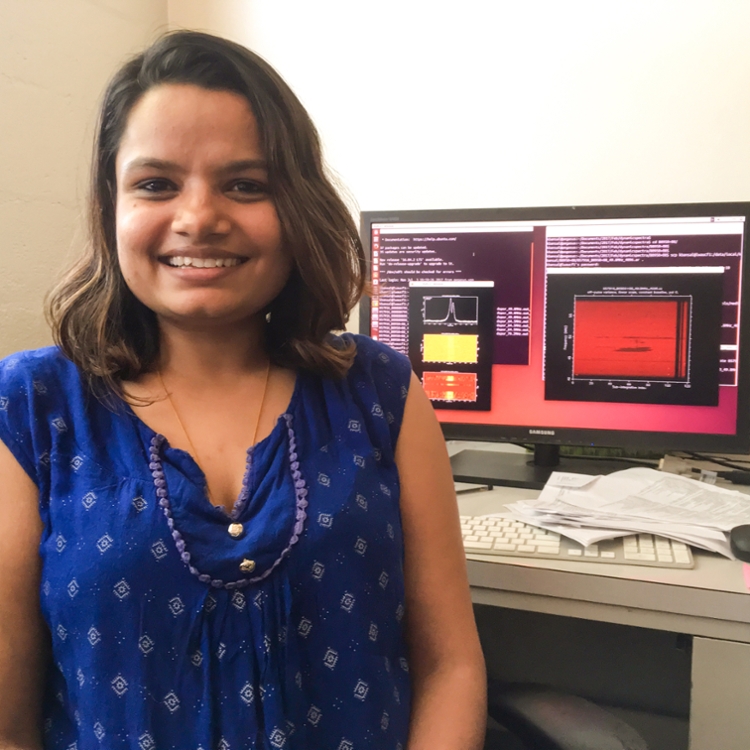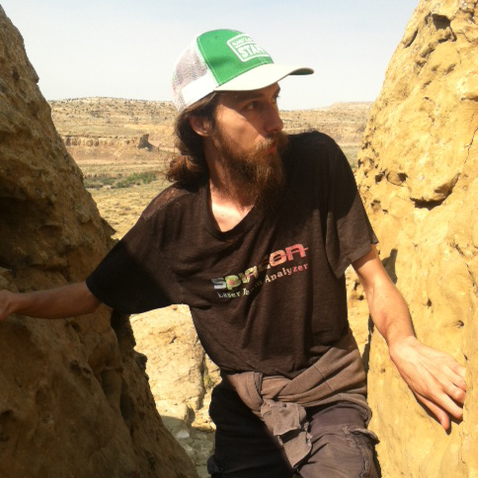Student Spotlights 2016-2017

Mike Stocz is a PhD student in the Sports Administration program at UNM. He received his M.S. and B.S. in Sports Management from Ithaca College and Winthrop University, respectively. Mike's work was recently published in 4 national journals and 1 local journal, in the areas of social media, risk management, and teaching assistants. These publications have been featured in, or are in press for, KAHPERD Journal, Journal of Physical Education, Recreation, and Dance, Mass Communication & Society, Journal of Sports Science, and Sport and Society. Currently, Mike is working on manuscripts surrounding food communication in sport, developing a minor league system for the NFL, and hooliganism.
Mike came to the University of New Mexico with the dream of becoming an assistant professor in Sports Management. He is currently on two leadership committees within student run organizations at UNM (Sport Administration Student Association, and the Health, Exercise, and Sports Sciences Graduate Student Association). Mike is also a shoe tester for New Balance, a frequent blood donor, and a teaching assistant for the HESS department. In his free time, Mike enjoys watching sports, swimming, and filming for a local sports broadcasting company in Albuquerque.

Rakeshkumar Mahto is a Ph.D. student in the Department of Electrical and Computer Engineering (ECE). Recently, he was awarded with Doctoral Travel Grant for presenting his work on resilient solar cells at the International Reliability Physics Symposium (IRPS) in Pasadena, CA. His research work is to make solar cells (photovoltaic) based power source, reconfigurable and resilient in case of fault or dim lighting condition by using transistor switches. He proposed and presented this novel concept in the Respace/MAPLD conference. He believes his techniques can be very useful to power micro-autonomous drones, CubeSats, and microsatellites. Recently, he submitted a paper where he presented a novel way to model solar cell module using MOSFET transistors which let the user model output current based on the output voltage, lighting coefficient, the number of solar cells in series, the number of solar cells in parallel and temperature which was previously only possible using the iterative technique.
Rakeshkumar Mahto is currently working under the guidance of Dr. Payman Zarkesh-Ha and Dr. Olga Lavrova. They will be building an embedded CMOS-on-PV cells at the Center for Integrated Nanotechnologies (CINT) in Albuquerque, NM to make the electrical connection of solar cells with transistor more reliable. Besides working on his thesis he has taught many undergraduate classes at the ECE department and for all the courses he has received an excellent rating.

Soumi Roy Chowdhury is a third year Ph.D. student in Economics with a focus in Health & Development Economics. She received her B.A degree and first M.A. degree from India where she has conducted field research in collaboration with Ministry of India and other foreign universities. She completed her second M.A. degree in Spring 2015 from University of New Mexico. She recently completed a research requirement "Balance and Power, Domestic Violence and Health Outcomes: Evidence from demographic and health survey in Nepal". Her current research focuses on socio-economic consequences of cancer in the context of Nepal. The project has been funded by American Cancer Society. She is currently in Nepal collecting data on cancer patients based on a survey that she and the Nepal Studies Center created. On the teaching front, she is currently the primary instructor for an undergraduate level Economics course in the department.

Gangadharan Esakki is a PhD student working towards his dissertation in the Department of Electrical & Computer Engineering (ECE) with a focus on Video compression standards (H.265/HEVC, x265, VP9), Adaptive real-time video communications and CODEC computational complexity in an optimization framework called DRASTIC (Dynamically Reconfigurable Architecture for Time-varying Imaging Constraints) funded by National Science Foundation grant. Prior to joining UNM, he received his Bachelor’s in Electronics & Communication Engineering with Distinction from Anna University in 2009 and his M.S. in Computer Engineering from UNM in 2014. Currently advised by Dr. Marios Pattichis at ivPCL (image and video Processing and Communications laboratory), his work is mostly based on developing optimization algorithms for real-time video encoding, camera motion activities, and complexity analysis. His other research interests include H.264/AVC, Machine learning, Computer vision, Statistics and Mathematical models.
He recently presented his research paper titled, Adaptive High Efficiency Video coding based on Camera Activity Classification at the 27th Data Compression Conference in Utah, one of the top conferences in the video coding/compression field. In 2016 while interning in Intel, he worked with Intel Real-Sense camera and contributed to the prototype models as part of the PERC (Perceptual Computing) group. Also, his research was supported with 2 patents that are covered under his NSF grant that won the UNM STC Innovation Award. Additionally, he has served on several student based associations at UNM including: the Graduate & Professional Student Association (GPSA 2015-2016) as a Council representative, the World Student Alliance (WSA 2013-2014) as a committee member, and the Indian Student Association (ISA 2012-2013) as Treasurer. Besides school, he enjoys his cup of cappuccino, writes blogs, teach/practice yoga, climb mountains, ski and volunteering for community service.

Doctoral student Karishma Bansal has made international news for her first-author (and her first-ever published!) article in the Astrophysical Journal regarding the groundbreaking discovery of orbiting black holes—one which could even help us see into the future of our very own galaxy.
Bansal worked with UNM’s Dr. Gregory Taylor and scientist from other universities on the discovery. For over a decade, Taylor and his colleagues utilized the Very Long Baseline Array – a series of 10 radio telescopes located across much of North America from Hawaii to the Virgin Islands with one telescope in western New Mexico—to conduct very fine measurement from enormous distances away from Earth. Bansal then used the collected data to prove orbital movement between the two black holes from measurements made since 2006 to present.
These orbiting black holes resulted from two galaxies merging together. Scientists have theorized this scenario was possible; as Bansal explains, “Any decent sized galaxy has a super massive black hole at the center, so given all those statistics we would expect these systems to be more common.” However, Bansal and Taylor’s work is the first to actually observe this phenomenon, a system which Bansal says is “the most complex . . . ever detected.” And, since our own Milky Way galaxy is due to collide with the Andromeda galaxy in about a billion years, Bansal and Taylor’s research gives us an advance view of what that collision and its effects could look like. The findings may also shed additional light on how gravitational waves work.
The project has attracted the attention of the campus, local, national, and international news media, even in her home country of India. Despite the press coverage, however, Bansal notes that she only has partial funding for the next school year. “You guys make me famous now, and nobody gives me money,” she says with a laugh, noting that as an international student she is ineligible for the bulk of funding available in her field.
Bansal came from India to UNM three years ago to work with Dr. Taylor. When she’s not busy making revolutionary astronomical discoveries, she goes hiking, biking, and participates in mixed martial arts to relax and, as she says, “kick some butt.” She is passionate about astronomy, has several projects in process, and hopes to pursue research in the field past graduation. Where would she go to research if she could choose?
“The South Pole,” she says with a smile. “They have pretty cool telescopes there.”

Fall is just breaking with crisp mornings and unpredictable skies. This particular morning the sun was bright, causing the raindrops to glisten on the chairs and table near the Student Union Building, when Fiorella Vera-Adrianzén bustled in with a busy schedule for the day ahead. “I have just returned here from 8 months in the field” she said, “and it is taking some time to get adjusted back to being here.” Her research focuses on post-conflict transitional justice in Latin America, as well as social welfare and grassroots development in the region. Her dissertation examines the efficacy of reparations at the individual and community levels in post-conflict Peru, which is where she was conducting fieldwork with the support of an Inter-American Foundation Grassroots Development Fellowship.
Fiorella was born and raised in Peru (Lima) where she went to Law School (an undergraduate program at the Pontifical Catholic University of Peru). After coming to the US, she attended UNM both as a McNair-ROP scholar and Honor’s program undergrad student and was summa cum laude for her B.A. in political science in 2010. She completed the M.A. in 2015 and is now a Political Science Ph.D. candidate at UNM. Her subfields of study are comparative and international politics – with focus on transition justice and human rights in Latin America. She gained Quechua language skills through her education in Peru and in the U.S. and participated in a cultural immersion and intensive Kichwa language training in Ecuador, as a Foreign Language and Area Studies Fellow. She is employing her robust research interests and language abilities to implement a dissertation project that contributes to the study and implementation of transitional justice in Peru and other countries experiencing similar post-conflict scenarios.
Her dissertation examines the efficacy of reparations for victims of the civil conflict in Peru (1980-2000) between Maoist insurgent groups (i.e. Shining Path) and state forces. The reparations program aims to provide justice and post-conflict reconstruction to disenfranchised indigenous communities, who were disproportionately affected by the conflict (80% of the victims were living in rural areas and 75% spoke Quechua or other indigenous language), through collective, individual, material, and symbolic reparations. Since 2007, collective reparations, one of the seven programs, have been provided to affected rural communities and organizations of displaced victims. However, only in the last few years, the other programs (i.e. education, health, housing, civil and political rights, monetary, and symbolic reparations) have gained traction. Across all these programs, for many individuals and communities affected by the conflict, “reparations should compensate them for the rights and life opportunities they lost or never had access to due to the violence they endured, recognizing them as human beings and citizens with full rights.”
Fiorella’s research will result in a template or framework by which reparation programs can proceed in Peru and other countries implementing reparative justice. Her approach is strongly composed of grassroots input and design and employs Quechua cultural and linguistic lenses. Fiorella returned from 8 months in the field – supported by the IAF fellowship – carrying out ethnographic work in Junín, Apurímac, and (mainly) Ayacucho regions and collecting initial survey data. She will return to the field to complete the survey in several provinces of Ayacucho and employ Fulbright Hays funding to support in-depth ethnographic work (focus groups, participant observation, and interviews) in selected case-study communities in Ayacucho, the most affected region by the conflict. She anticipates finishing her degree in May 2019. After that, Fiorella wants to continue research as an applied researcher and work towards fueling policy development in the areas of justice and grassroots development in order to improve peace-building, conflict management, democracy and human rights in Latin America and elsewhere in the world.

Jacek Ksawery Osinski, 2017 recipient of the Office of Science Graduate Student Research (SCGSR) award conferred by the U.S. Department of Energy (DOE), was selected among 52 applicants for this competitive award. This gives Jacek an important opportunity to advance his doctoral thesis while gaining the additional expertise and resources available at DOE laboratories. Although he could have chosen any of the 17 national labs, Jacek will take his six months of support to work and live at Los Alamos National Laboratory (LANL) where scientists will train him in theoretical particle physics. More about the award can be found here.
Jacek’s research is focused on events that occurred 13.7 billion years ago, specifically the time between the Big Bang that created what we know as the universe and one second after that event. This time period, when the universe was less than one second old, has no observational link to the current time, and getting to within one second of the Big Bang will allow Jacek to probe the origin of the universe. Specifically, Jacek’s research explores three paths: 1) the connections between black holes and dark matter; 2) a two-field model of matter domination and relevance of Weakly Interacting Massive Particles (or WIMPS); and, 3) a particle physics question involving how dyon particles in the hidden sectors of the universe (versus observable sectors) interact. Although these lines of inquiry may seem “far out,” they are all related through their ability to probe properties of the early universe once dark matter is detected.
Jacek’s thesis is concerned with non-standard dark matter production mechanisms. Jacek has a publication about very small, particle-sized black holes that could provide a source for dark matter. Since dark matter is a major constituent of the universe, detecting this | will be one of the greatest discoveries in physics. The way Jacek is thinking may very well make this discovery even more meaningful through the connections to the origin of the universe that he is developing. And there is competition as well as coordination on the dark matter discovery. For example, some competing theories involve very light particles “sub-GeV” dark matter that could be accelerated to very fast speeds (exceeding 600 km per second) creating particles that could hit the sun, become accelerated, and then encounter Earth. Advancing technology in detectors could see these particles.
After graduating from Albuquerque Academy, Jacek enrolled at UNM and finished his Bachelor’s in Astrophysics in 2013 when he advanced directly into the graduate program. He plans to complete his Ph.D. in 2018/2019 and start a post-doc the following year. He would like either to work in a national lab or teach physics in a small liberal arts school associated with Big Science collaborations. Jacek spends his time thinking deeply about hidden interactions and dark matter. Now that he will have a little time on his hands (about one second), Jacek may lead us to actually seeing in the dark.
